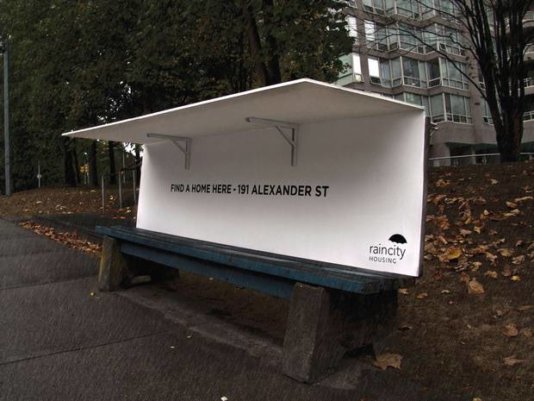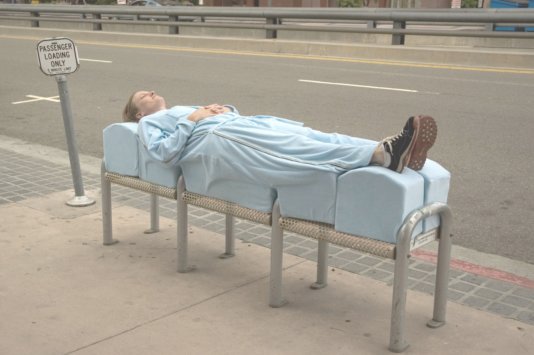- About
- Topics
- Story
- In-Depth
- Picks
- Opinion
- News
- Donate
- Signup for our newsletterOur Editors' Best Picks.Send
Read, Debate: Engage.
| August 15, 2015 | |
|---|---|
| topic: | Human Rights |
| tags: | #architecture, #defensive architecture, #homeless, #urban design, #vagrants |
| located: | Germany, China, USA |
| by: | Vanessa Ellingham |
If you’ve ever sat at a bus stop and found yourself being tipped forward by the seat, or leaned back against a wall only to have a sharp window ledge stab you in the back, or found that the arm rest on a public seat is too sharp and angular to actually rest your arm on, then you know exactly what defensive architecture is all about: public spaces rejecting human bodies.
The aim of defensive architecture is to keep ‘undesirable’ members of the public from hanging around too long: the homeless, the vagrants, those who loiter. Despite the idea of public space belonging to everyone, the very opposite is reinforced with everything from seating designed to be impossible to lie on, or classical music playing at bus shelters to discourage loitering teenagers, to rows of concrete bollards placed, for example, under bridges, deeming the space unfit for sleeping on.
Pavement sprinklers keep building entrances clear all around the world (including outside a book store in New York, a fashion chain in Hamburg and Government buildings in China), even when they are closed after hours.
Earlier this year the management team of a San Francisco cathedral were left red-faced after it was exposed that sprinklers had been installed there to douse homeless people seeking shelter under the cathedral’s doorways. The sprinklers were removed after a public outcry – many, obviously, quoted biblical passages about loving thy neighbour.
A set of “anti-homeless” spikes installed outside a London residential complex in 2014 became a very visual symbol of the defensive architecture movement, and social media ran hot with complaints. Following a petition, a sleep-in protest and Boris Johnson getting very angry, the spikes were eventually removed. But there aren’t always charitable people around to make these complaints – and the people the architecture targets are generally not powerful enough to have their complaints heard.
----
Defensive architecture displays a particular breed of unkindness, which is not accidental, but rather considered, deliberate. It is explicit in its intention to exclude.
But as for the matter of who it excludes, defensive architecture cannot always be so precise. Its brand of hostility is quite democratic. The hard, cold, metal arm rests attached to bus stop seating may prevent a homeless person from lying down, but they may also prevent an elderly person from being able to properly rest after a shopping trim, a parent from sitting close to their children, or an overweight person from being able to fit into the seat at all.
Even further than the physical barriers, hostility breeds hostility. By discouraging people from enjoying public space, defensive architecture asks us all to retreat further into our homes and ourselves.
----
The symbolism of architecture has never been lost on politicians – whole books are dedicated to single movements and the impact on their people. Just one visit to see the remnants of Nazi architecture in Berlin and you’ll never forget it.
Greek politicians from the Syriza party were recently able to use this to their advantage. By removing the metal barriers between the Hellenic parliament and a public square they sent a clear signal to the Greek people: we are one and the same; the struggle between the state and the public ends here. It didn’t, of course, but removing the visible, physical barriers was a good start.
In Vancouver an organisation which supports homeless people created a series of pop-up shelters which function as public benches by day, but can roll up to provide overhead shelter at night. As part of their advertising campaign, a sign on the structures, made visible by UV sunlight, read, “this is a bench”, during the day, while at night, glow-in-the-dark letters replaced them to display the message, “this is a bedroom”.
----
The boundless creative possibilities created by defensive architecture have not been lost on artists.
Nils Norman, who calls defensive architecture a “vernacular of terror”, has been documenting the practice since the late 1990s. His website functions as a vast repository of photographs of public spaces designed to prevent human use, categorised into various searchable groups including “bum free”, “anti graffiti”, “anti skate”, “anti climb” and “audio and light devices”.
The sculptor Fabrian Brunsing took a satirical approach to defensive architecture with his installation, the Pay Bench. The Pay Bench was a very ordinary park bench, except for the metal spikes protruding from the seat, which would only retract when the user paid the coin machine attached.
The kicker? Officials in the Chinese province of Shangdong completely missed the point, taking inspiration from Brunsing's design and installing similar pay benches in a public park.
Some people really are beyond help.
By copying the embed code below, you agree to adhere to our republishing guidelines.



